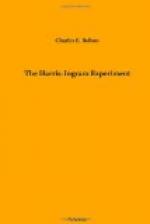The steamer signals, “We want a pilot,” by burning a blue light on the bridge, and bears down on the pilot schooner. The moon reveals enormous figures, with a heavy dot beneath, on the mainsail of the schooner. Over the rail goes the yawl, followed by the oarsman and pilot, whose turn it is to go ashore. The pilot carries a lantern, which in the egg-shaped yawl dances on the white wave crests up and down like a fire-fly. The yawl is soon under the steamer’s lee, and a line from the big ship pulls the little boat to the ladder, and the pilot nimbly climbs to the steamer’s bridge, bringing the latest papers. The schooner drifts under the steamer’s stern, takes in the yawl, and again sails to the eastward in search of another liner.
The entrance to the port of New York is patrolled night and day by a pilot-fleet of thirty boats, which cost from $10,000 to $20,000 each. They are staunch and seaworthy, the fastest schooners afloat. Often, knocked down by heavy seas, for a moment they tremble, like a frightened bird, then shaking the water off their decks, they rise, heave to, perhaps under double reefed foresail, and with everything made snug, outride the storm, and are at their work again. Pilots earn good pay, and this they deserve, as they often risk their lives in behalf of others.
Sandy Hook Light was now in sight, and long before the sun began his journey across the heavens, the steamer lay at anchor at quarantine, waiting for a certificate from the health officer. As the steamer proudly sped through “The Narrows,” a jubilant crowd of passengers on the promenade deck sang,
“My country ’tis of thee
Sweet Land of Liberty,
Of thee I sing;
Land where my fathers died;
Land of the pilgrim’s pride;
From ev’ry mountain side
Let freedom ring.”
The hymn was sung to the tune of “God Save the Queen,” and several enthusiastic Englishmen joined with their kith and kin.
On Bedloe’s Island Bartholdi’s Statue of Liberty waved her torch, outward bound steamers exchanged salutes, the Brooklyn Bridge and all the ferries were thronged with people hurrying to the labor marts of the metropolis, as the steamer with George and Gertrude aboard moved up the harbor and was safely docked on the North River.
In the lead down the gangway Gertrude hastened George to secure a carriage for their hotel, so anxious was she to reach rooms on American soil, where she might honorably break the seal of her father’s mysterious big blue envelope. It had rarely been out of her mind since the day of her wedding in Paris.
After breakfast, served in true American style, the Ingrams glanced at the big morning papers crowded with American news, and wondered why European papers printed so little about the States. Then they retired to their rooms to break the seal of the blue envelope.
George was all attention as his young wife with the flush of health and excitement in her cheeks tore apart the envelope, and stepping to the window for better light, she began to read Reuben Harris’s letter.




